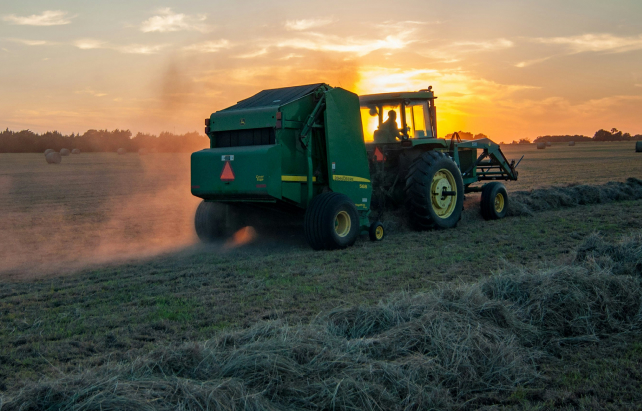Fractal CEO Ben Gordon sat down with Maverick Ag co-founders Kristjan Hebert and Evan Shout on the Real Agriculture podcast for their thoughts on why growth today is fundamental to long-term success and how to grow strategically.
With decades of experience running Hebert Grain Ventures—a 40,000-acre grain and oilseed operation in Saskatchewan—they offer a wealth of insights on how to leverage land investment, financial management, and strategic partnerships to achieve your goals.
Here’s what you need to know.
1. Think about how your land & Operating Entity Work Together To grow your farm.
For Kristjan and Evan, a farming operation is fundamentally two interconnected entities: a real estate business and an operating business. The real estate business helps you access capital needed to grow your operation by borrowing against your owned equity. The operating business helps you cashflow this additional debt load. As you pay down principal and your real estate appreciates, you have more to borrow against, which further fuels growth.
“A lot of guys are making decisions based on the well-being of the farm as one entity. You really have two totally separate entities – a real estate business and an operating business – and we need to start looking at the real estate return versus the cost to run the farm. You have to know which one is higher.” – Evan Shout
2. scale Can drive efficiencies, reduce costs, and gain leverage.
Scale can help you drive asset utilization and increase contribution margin to generate more cashflows. It drives efficiency and lowers fixed costs per acre. It gives you more negotiating power – whether in marketing, input procurement and pricing, or securing financing. Scale can reduce your vulnerability to a single landlord or supplier and improve overall operational resilience – but it can never compensate for bad management.
“Growth is your best thing to fix most problems. If scale is done correctly, it frees you to do stuff that actually drives your bottom line.” – Kristjan
3. be strategic in how you balance working capital and Farm Cashflows.
When scaling operations, farmers need to continually be cognizant of how they manage their working capital and farm cashflows to ensure they don’t get over-extended with their lender. In today’s low margin and high interest rate environment, taking on more debt amplifies risk. A poorly timed land purchase—especially one financed solely with debt—can strain working capital. Exploring creative financing options like equity capital allows you to leverage your existing land to buy more while preserving cash flows.
“As farmers, we forget that we don’t always have to take out a loan. Sometimes you could just pay cash. There are different ways to do things depending on your cash flow, and there’s a difference looking at the cash flow side of an asset versus the long-term investment side of the asset. As farms, we have better years. You can store some of that wealth in your land or use it to write a check for more land – because there’s a difference in paying cash or taking out a 30-year loan for it.” – Evan
4. You can’t be strategic if you don’t know your numbers.
It starts with knowing your bank ratios. Farmers who understand their financial position—and work proactively with their lenders—have a significant competitive advantage. Kristjan and Evan will send a proposal over to the bank two weeks before their meeting outlining what they’re asking for. Securing pre-approvals for financing gives them the ability to act fast – without waiting on the bank – and can mean the difference between securing the deal or missing out.
“I knew on February 28 I could spend $10 million on land, $3 million on equipment, $4 million on buildings, and I didn’t need to go ask if it was pre-approved. So when land comes up, I don’t have to ask my banker if I can get that loan. I just shake the guy’s hand and write him a check for a million dollars” – Kristjan
5. To stay competitive, farmers can no longer afford to go it alone.
Deals are getting bigger and moving faster. Whether through joint land purchases, bulk buying agreements, shared equipment, or innovative rental partnerships, working together can reduce costs, increase negotiating power, and improve financial resilience. For some, this will require a mindset shift—moving away from seeing neighboring farms as competition.
Capital partners with shared goals and aligned incentives can also help keep you competitive – but it’s important to choose partners with aligned incentives and shared skin in the game.
“A lot of farmers want to be in charge of everything. We’re going to have to change that mentality, because scale gets us power on procurement, power on financing. You’re gaining some of that power back against the industry that has already consolidated against us. If you want to take some of that power back, you’re going to have to start working with other farms to get scale. Collaboration will determine how wide the gap is between guys who are really growing fast and guys standing still.” – Evan
Don’t miss out on all the great insights from this hour-long podcast. Check out the full conversation here.
Note this is not investment advice. The information contained should be used for informational purposes.
LEARN HOW TO UNLOCK YOUR EQUITY
"*" indicates required fields
We hold your data in high regard. By submitting this form, you are consenting to the use of this information in compliance with our Privacy Policy.


